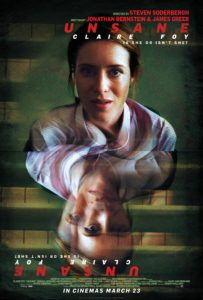Unsane, 2018.
Directed by Steven Soderbergh.
Starring Claire Foy, Joshua Leonard, Jay Pharoah, Juno Temple, Polly McKie, Amy Irving, Sarah Stiles, and Matt Damon.
SYNOPSIS:
A young woman is involuntarily committed to a mental institution, where she is confronted by her greatest fear–but is it real or a product of her delusion?
Unsane remains engaging throughout, with a tipping point that transforms the ambiguity of the mental health thriller without transitioning to a different genre. The subtlety in this chess move is assuredly one that only an accomplished and revered director such as Steven Soderbergh could pull off without drawing a disorienting amount of attention unto itself. One minute the age-old traditional horror question of “Is she crazy or not” is being analyzed among other related themes (there are dark humor and wit to some of the dialogue exchanges that scathe the ethics behind mental institutions and insurance companies), before suddenly a new dynamic offers up other, slightly less interesting, things to ponder.
Without spoiling anything, it is safe to say that for some viewers, myself included, Unsane shows its hand an entire act early; Soderbergh (this is his second film after coming out of filmmaking retirement following up last year’s redneck heist dry comedy Logan Lucky, now journeying into horror the furthest he has ever gone, bringing to life a script from shorts creators Jonathan Bernstein and James Greer) is terrific at doling out enough details from both sides that make us contemplate what is actually going on. This is answered directly with quite a sizable chunk of the film left, disappointingly going down a more cliché subgenre of horror (the vagueness is intentional) that does not really suit the complexity of the narrative. Making matters worse, the final 30 minutes tend to drag complete with repetition settling in.
Erase all of that and Unsane is fist-clenching suspense, fully getting underway as Sawyer (Claire Foy, most known from British television series The Crown) charges head first into the wall of her apartment right as she is about to consent to sexual relations with a stranger from a bar. From there, the seemingly unstable individual begins Internet researching for treatment facilities specializing in stalkers, believing the man from the night prior was a previous obsessed lover. After a session of counseling where she admits to every once in a while feeling suicidal, the establishment pulls a shady tactic tricking her into signing herself over overnight to the half-house where she encounters a man (this time a facility employee played by Joshua Leonard) that she swears up and down is the man that has been stalking her, going to extreme lengths such as changing his name and working undercover.
The reason much of this works is largely due to the unconventional filmmaking style Soderbergh is operating under here, choosing to film everything using an iPhone camera (the film’s aspect ratio even reflects this creative decision), but also by using that choice of cinematography to frame scenes and character interactions from unorthodox angles. When not zoomed in squarely on Sawyer’s face (Claire Foy makes the most of such instances, constantly fidgeting and blinking in excess, also maintaining wide-eyed facial expressions, all these tics superbly doing their part to play up the mystery regarding her level of sanity), the audience is given perspectives from behind characters (often at unusual heights ranging overhead and low to the ground in the corners of rooms) imbuing the experience with a “fly on the wall” feeling. Essentially, it can feel like watching surveillance footage, but on a more awkward and uncomfortable wavelength. There are also close-ups of certain objects crowding the foreground, and while sometimes the decision is irrelevant, Soderbergh typically has a good reason for doing so and delivers a huge payoff with that same item.
Obviously, Sawyer is not alone in the mental institution, surrounded by a colorful cast of supporting characters, some who seem to be entirely capable of functioning in society normally (Jay Pharoah recovering from an opiate addiction, way too relaxed and chill for the environment). Of course, there are also some caricatures of the average nutjob one would expect to see inside of a hospital like this (Juno Temple sells the hell out of her wacko persona constantly getting confrontational and pulling on her dreaded hair like a crazy person would). It leaves viewers soaking in the core theory of “Is everyone here locked away really insane or part of a bigger picture scam?” and how that scarily relates to the real world. Unfortunately, this subtext also somewhat gets lost in the shuffle once the plot changes direction.
Even considering that Unsane does have one really smart detail revealed regarding a certain character during the iffy third act, and keeps tension heightened thanks to a pair of winning performances from Claire Foy and Joshua Leonard, there is an inescapable sensation that at times the movie gets too silly and diverges too much from its original concept. Sure, there is still curiosity over how things will end, but momentum is lost at a critical point. The worst part is that the film is unaware of this and keeps going, ending on a conventional, predictable, and flat note. Still, it is a suspenseful and well-acted win for Soderbergh that successfully captures his dry mood inside of a twisty psychological thriller.
Flickering Myth Rating – Film: ★ ★ ★ / Movie: ★ ★ ★ ★
Robert Kojder is a member of the Chicago Film Critics Association and the Flickering Myth Reviews Editor. Check here for new reviews, friend me on Facebook, follow my Twitter or Letterboxd, check out my personal non-Flickering Myth affiliated Patreon, or email me at MetalGearSolid719@gmail.com














